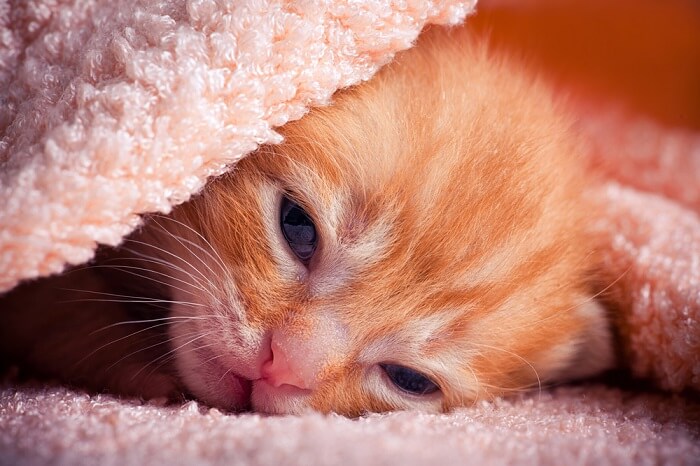
What Is Eye Disease in Neonatal Kittens?
Neonatal (newborn) kittens can develop eye infections, also called “ophthalmia neonatorum,” as young as a few days to a few weeks of age.
Most often, neonatal eye infections develop from bacteria or viruses transmitted from the queen (mother cat) during birth.
Common symptoms of neonatal eye infections are red, irritated eyes with pus-like eye discharge, and the eyelids may become severely swollen and stuck together. Antibiotic eye medications are usually prescribed to treat the infection and thankfully most kittens recover quickly from the infection.
Some kittens can develop adhesions between eye membranes with permanent scarring and damage to the cornea, which might affect their vision long term.
Quick Overview: Eye Diseases in Neonatal Kittens
 Other Names: Ophthalmia neonatorium
Other Names: Ophthalmia neonatorium
 Common Symptoms: Red inflamed eyes with discharge, swollen lids, lids crusted shut, squinting, ulcerated or cloudy corneal surface
Common Symptoms: Red inflamed eyes with discharge, swollen lids, lids crusted shut, squinting, ulcerated or cloudy corneal surface
 Diagnosis: Supportive findings on exam of the eye, positive result when fluorescein stain is used. Bacterial culture in some cases.
Diagnosis: Supportive findings on exam of the eye, positive result when fluorescein stain is used. Bacterial culture in some cases.
 Requires Ongoing Medication: If related to herpesvirus, L-lysine or other similar supplement may be recommended to reduce episode recurrence.
Requires Ongoing Medication: If related to herpesvirus, L-lysine or other similar supplement may be recommended to reduce episode recurrence.
 Vaccine Available: Not specifically, though the herpesvirus/feline viral rhinotracheitis component of the FVRCP vaccine may protect against herpesvirus as a cause.
Vaccine Available: Not specifically, though the herpesvirus/feline viral rhinotracheitis component of the FVRCP vaccine may protect against herpesvirus as a cause.
 Treatment Options: Antibotic drops or ointment, pain medication, anti-viral medication if related to herpesvirus, surgery in rare cases may be needed.
Treatment Options: Antibotic drops or ointment, pain medication, anti-viral medication if related to herpesvirus, surgery in rare cases may be needed.
 Home Remedies: A warm compress using a damp washcloth on the closed eye may help with some degree of discomfort, swelling, and discharge.
Home Remedies: A warm compress using a damp washcloth on the closed eye may help with some degree of discomfort, swelling, and discharge.
Symptoms of Eye Disease in Neonatal Kittens
Neonatal conjunctivitis can develop in one or both eyes and may be present in multiple kittens from the litter. The queen may or may not be showing any signs of illness.
Kittens affected with neonatal eye disease may show symptoms such as:
- Watery eyes
- Eye discharge (pus-like, sticky, yellow to green)
- Redness to the eyelids and conjunctiva
- Swelling of the eye membranes
- Conjunctiva sticking to the eye surface
- Clouding or haze to the cornea
- Eyelid edges sticking together
- Swelling or bulging of the eye socket
Kittens may also show some signs of an upper respiratory infection such as:
Causes of Eye Disease in Neonatal Kittens
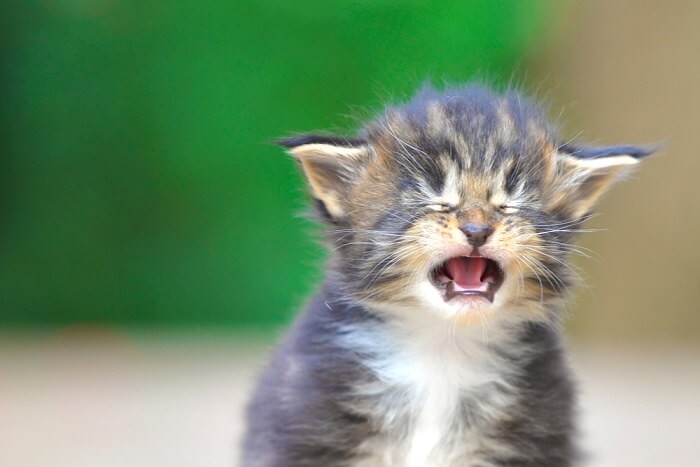
There are a number of reasons why neonatal kittens may develop eye disease, including infections transmitted from the mother cat.
Neonatal eye infections can be transmitted from the queen either before or during birth, or from dirty living conditions.
Bacteria are often transmitted from the queen to the kittens during birth from infected vaginal secretions, but the feline herpes virus can be transmitted to kittens in utero, meaning they are born with the infection.
The most common infections to cause neonatal eye disease include:
- Staphylococcus spp. bacteria
- Streptococcus spp. bacteria
- Feline herpes virus
- Feline chlamydia (Chlamydophila felis bacteria)
Diagnosis of Eye Disease in Neonatal Kittens
A veterinarian should examine any kittens with clinical signs of eye disease, and the queen may need to be examined as well. A complete physical exam will help detect any systemic illness and your vet may recommend testing like bloodwork or urine analysis. Bacterial testing of vaginal discharge from the queen may also be necessary.
An eye examination will determine if an eye infection is present in the conjunctiva or cornea, or if there is another cause for the symptoms. If the eyelids are stuck together, your veterinarian will need to clean and gently separate the eyelids to release the infection and may take a sample for analysis. The eye examination should include a fluorescein stain to check for ulcers on the cornea which require more aggressive therapy.
Treatment of Eye Disease in Neonatal Kittens
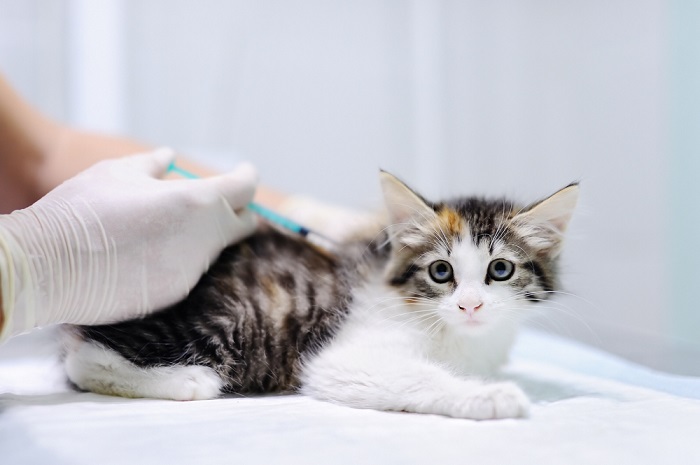
Antibiotics are the most common treatment for eye diseases in neonatal kittens.
Antibiotics
Eye infections in kittens are most often treated with topical antibiotics. Feline herpes virus isn’t a bacterial infection, so antiviral medications might be needed if your vet suspects this as the cause.
Cleaning and Warm Compresses
If your kitten’s eyelids are sticking together, your vet will clean and gently open the eyelids to rinse out the infected debris and allow treatment with eye medications.
To prevent the buildup of eye discharge, you will need to apply warm compresses and do gentle cleaning at home, in addition to completing the medications prescribed by your vet.
Depending upon the cause of the infection, your vet may recommend separating sick kittens from healthy ones or provide hygiene recommendations for the home environment and queen.
Recovery of Eye Disease in Neonatal Kittens
If the neonatal eye infection is treated appropriately and timely, recovery is generally quick. However, if the eyelid membranes are not separated and/or if the infection is not treated in a timely manner, permanent adhesions can develop.
These tissue adhesions, called symblepharon, can cause serious scarring, eyelid deformities, and may limit vision. Corneal ulceration that develops during a neonatal eye infection can have devastating consequences including rupture of the eye.
Bacterial infection in a corneal ulcer requires intensive medical treatment and your vet may recommend referral to a specialist in ophthalmology.
Frequently Asked Questions?
Why do baby kittens get eye infections?
Eye infections in baby kittens, also called neonatal conjunctivitis or ophthalmia neonatorum, is usually caused by the queen (mother cat) transmitting Staph or Strep bacteria to the kittens from infected vaginal secretions at the time of delivery. Viruses like feline herpes and dirty living conditions can also lead to eye infections in baby kittens.
How do you treat a kitten's eye infection?
Eye infections in kittens are treated with prescription antibiotic eye medications and sometimes antiviral medications. Any kitten showing symptoms of an eye infection, like swelling or eye discharge, should be taken to a veterinarian promptly for examination and treatment. The kitten’s eyelids can become stuck shut with debris, trapping the infection underneath, and your vet will soak and gently open the eyelids.
Can a cat eye infection spread to humans?
It is very unlikely that the bacterial infections causing eye infections in neonatal kittens will spread to a person. Practicing good handwashing and keeping good hygiene of the environment is recommend to reduce the spread to other cats. The feline herpes virus is not able to be spread to any other species other than cats but is highly contagious amongst cats through infected respiratory or eye secretions.
-
Stiles J. Feline ophthalmology. In: Gelatt KN, Gilger BC, Kern TJ, eds. Veterinary Ophthalmology. 5th Ed. Hoboken, NJ: Wiley-Blackwell; 2013:1477-1559.
-
Stiles, J, Reinstein, SL. Feline Herpesvirus Ophthalmic Diseases. In: Reinstein SL, ed. Guide to Clinical Ophthalmology. 1st ed. NAVC Media; 2019:93-106.
-
Hartley C. Aetiology of corneal ulcers assume FHV-1 unless proven otherwise. J Feline Med Surg. 2010 Jan;12(1):24-35.
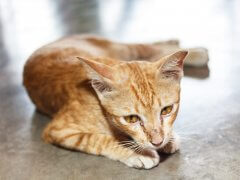
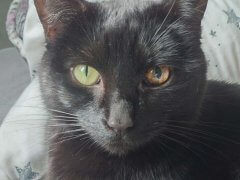

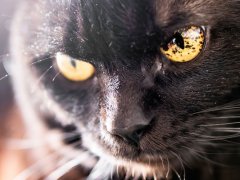




My adopted mix breed male cat {Tysong} was found in a ditch along side of the Reid. He was thought to be a piece of trash. But as we all know trash doesn’t meeeow, or at least not load enough for humans to hear. P.S. His three soils black siblings weren’t alive. He was guessed to be about 4 to 5 was of age at the Vets. But anyway, my question is, can a cat become nearsighted? Tysong is part Siamese by looking at his coloring and markings.
Sincerely a cat lover from birth,
Cheryl
Cats can develop vision problems, and yes, nearsightedness has been reported among cats. If your cat seems to be having vision issues, a trip to the vet will help you identify the cause.